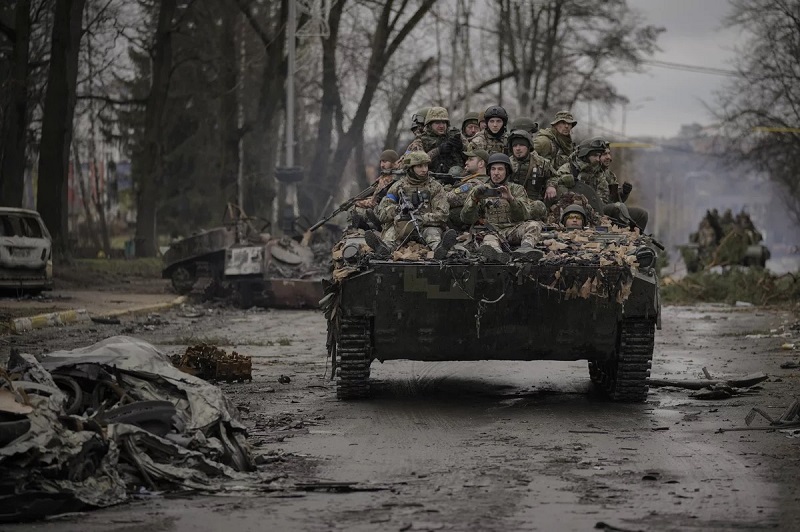
SHORN of accretions, bombast and battlefield excesses or successes, the war in and over Ukraine appears to be the first militarized front in Cold War 2.0. This inference (or extrapolation if you may) accrues , in the main from the nature of weaponry given to Ukraine- mostly in the nature of ones that assist in dragging the war and not winning it) and the statements of the US president. So which way will the battlefront turn? Contrary to triumphalist commentary (which has propaganda value), the Russian invasion of Ukraine has not failed; it has stalled. But stalling can also be construed as failure, given the Russian military machine’s optimistic assumptions about itself and Russia’s sense of self.
What, at this stage, would stalling mean- both in narrow and broad terms?
Technically and tactically, the reasons for stalling are obvious: overstretched Russian supply lines and logistics are its key vulnerabilities. All that Ukrainian forces need to do, is to attack these vulnerabilities, and make Russian advances difficult. But this cannot be a long term strategy: Russia is a state that can galvanize its resources and oil its military machine to seize the initiative again. It can also indulge in feints and manoeuvres that addle the Ukrainian forces. For example, feints like lulls in fighting, withdrawal and reconfiguration of forces can confuse Ukrainians, making them believe in battlefield withdrawals. This can then be exploited by Russian forces to make fuller and more vigorous assaults on key Ukrainian vulnerabilities. The issue then becomes of attrition: who will be worn out first or in crude terms, who will blink first?
On the surface, if the merit and rationale of unprecedented sanctions is to be believed, these will hit the centre of gravity of Russia’s military machine, making it difficult for Russia to sustain its military campaign. Complemented by a quasi-hybrid fighting- guerrilla plus conventional campaigns against Russians by Ukrainian forces, Russia’s ‘will and resolve to fight’ will be weakened. This then can become a predicate for negotiations and peace talks. If this is the dominant paradigm of thinking in the West, it is flawed. For Russia, the stakes are high; it is not merely about Ukraine and its status. The war aims are wider and deeper. Plus there is Russian prestige involved as well.
If boxed into a corner and if pursuing the Ukraine war is viewed by Western strategists as also being a component of ‘regime change’ in Russia, the country, with its loose nuclear doctrines retains the ultimate weapon to force choices on the West. Or, if escalation, through advanced weaponry to Ukrainian forces that if not balance but blunt Russian weaponry is chosen as an option, then Ukraine actually becomes a clear and present theatre of war between the West and Russia. Yet again, it is attrition that becomes key.
Against this backdrop, what options are likely to be made operational?
Admittedly speculative, it appears that the war in and over Ukraine is a ‘long haul’ war. Russia may capture more territory, consolidate its gains and use these in negotiations and ‘peace’ talks. If this scenario pans out, then Ukraine will , to use a metaphor from elsewhere, become a ‘moth eaten’ Ukraine. To state the obvious, this status will galvanize and provoke Ukrainian nationalists to continue their resistance – skirmishes, guerrilla attacks and even combat of a limited nature- a condition that might be seen somewhat tolerable by Russia. What will tilt the balance of forces will be the kind and nature of support that the West will give to Ukrainian nationalists. I would surmise that , from a macro , broader perspective, the West will maintain the robustness and ferocity of sanctions on Russia and , at the same time, arm Ukrainian nationalists to the extent of bleeding the Russian military machine. It would appear , short of a full war, where NATO and even American forces get involved, but which risk the use of nuclear weapons by Russia, there might not be other options available (or usable) to the West.
The war in and over Ukraine then morphs into the first militarized battle front into what is now decidedly Cold War 2.0. China will draw its own conclusions from the saga and perhaps enhance and amplify its military and naval capability modernization efforts more vigorously. The world then becomes a more militarized place, divided into blocs defined by either balancing or bandwagoning by other states. In this world, diplomacy lest the fraught militarized world stumbles into a broader war assumes salience and precedence. All in all, a bleak scenario that belies the theories of progress and that of the 21st century. In this melee and recrudescence of the world, international relations and world politics into a zero sum game of war and peace, the highest price is being and will be paid by the people of Ukraine.
Views expressed in the article are the author’s own and do not necessarily represent the editorial stance of Kashmir Observer
- The author is a writer based in Srinagar
Follow this link to join our WhatsApp group: Join Now
Be Part of Quality Journalism |
Quality journalism takes a lot of time, money and hard work to produce and despite all the hardships we still do it. Our reporters and editors are working overtime in Kashmir and beyond to cover what you care about, break big stories, and expose injustices that can change lives. Today more people are reading Kashmir Observer than ever, but only a handful are paying while advertising revenues are falling fast. |
| ACT NOW |
| MONTHLY | Rs 100 | |
| YEARLY | Rs 1000 | |
| LIFETIME | Rs 10000 | |













